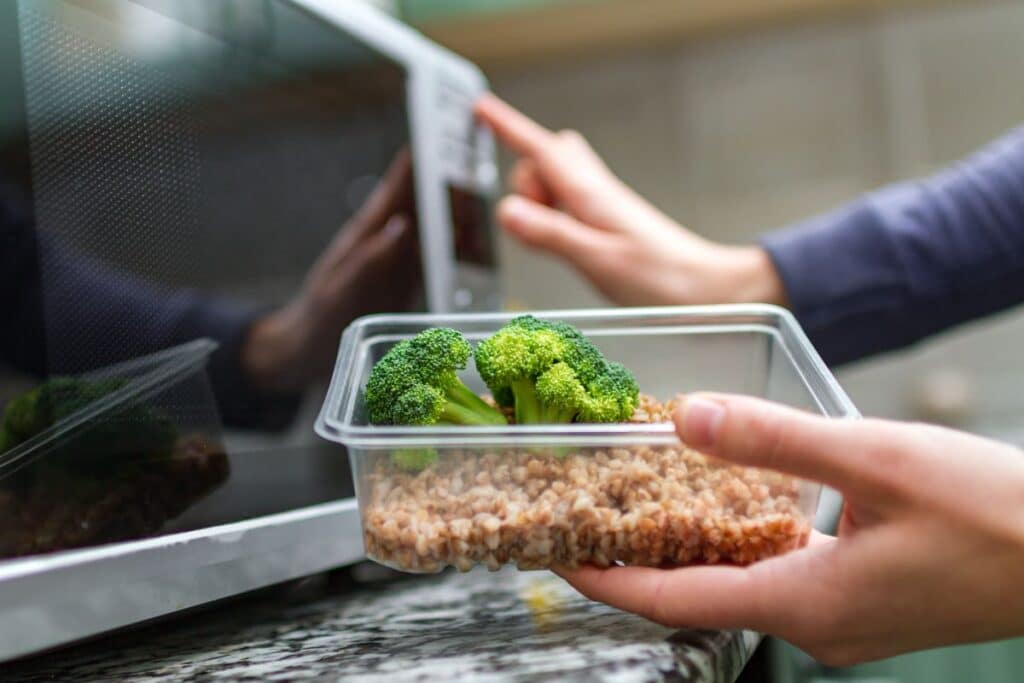When it comes to heating up food, convenience is key. But what about using plastic containers? With conflicting information and concerns about health risks, many people are left wondering: can you heat food in plastic containers?
You can heat food in plastic containers as long as you are using the right types. Plastic containers that are labeled as microwave-safe are typically made of materials that can withstand high temperatures and are less likely to release harmful chemicals.
In this topic, we’ll explore the different types of plastic containers and their safety for use in the microwave or oven, as well as tips for safely heating and storing your food.
Quick Navigation
- Is It Safe to Microwave Plastic Containers?
- Types of Plastic Containers and Their Safety
- Health Risks Associated with Heating Food in Plastic Containers
- Alternatives to Plastic Containers for Heating Food
- How to Reheat Food Safely in Plastic Food Containers
- Ideas to Remember
Is It Safe to Microwave Plastic Containers?
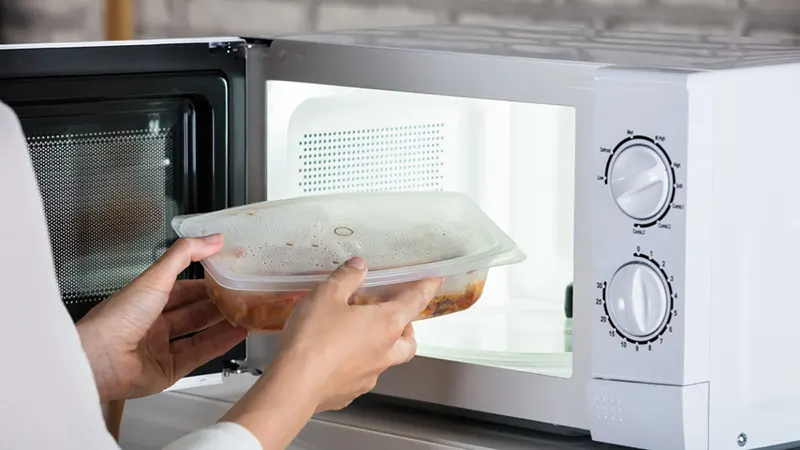
Microwaving is a standard method for heating food, but it can impact plastic containers and potentially release harmful particles into the food.
When a plastic container is exposed to high temperatures, such as those generated by microwaves, the plastic can break down and release chemicals into the food.
This process is known as leaching, which can transfer harmful substances, such as Bisphenol-A (BPA) and phthalates, into the food being heated.
Additionally, microwaving plastic food storage containers, especially in high heat, can lead to brittle, crack, or warp. This can result in further breakdown of the plastic and an increased release of chemicals into the food.
It is essential to follow the manufacturer’s guidelines and to use only microwave-safe plastic storage for heating food in the microwave.
Consumers should also avoid exposing plastic storage to high heat and should not reuse plastic utensils that have become damaged or distorted.
Types of Plastic Containers and Their Safety
In a nutshell, here is a table outlining the safety of different types of plastic containers for heating food:
| Plastic Type | Safety for Heating Food |
| #1 PET (Polyethylene Terephthalate) | Not recommended for heating Can release harmful chemicals when heated |
| #2 HDPE (High-Density Polyethylene) | Generally safe for heating in the microwave |
| #3 PVC (Polyvinyl Chloride) | Not recommended for heating Can release harmful chemicals when heated |
| #4 LDPE (Low-Density Polyethylene) | Generally safe for heating in the microwave |
| #5 PP (Polypropylene) | Generally safe for heating in the microwave |
| #6 PS (Polystyrene) | Not recommended for heating Can release harmful chemicals when heated |
| #7 Other (Includes Polycarbonate and Polylactide) | Not recommended for heating Can release harmful chemicals when heated |
It is important to note that plastic or takeout containers can be marked with a recycling symbol that indicates their type, but this may not necessarily mean their safety for use with food, especially when heated.
Consumers are advised to be cautious and follow recommended food storage and heating guidelines to steer clear of potential exposure to certain chemicals.
There are several types of plastic containers commonly used for storing and heating food, including:
Polyethylene Terephthalate (PET or PETE): This type of plastic is widely used in single-use containers such as water bottles and beverage containers. It is considered safe for one-time use but not recommended for reuse, especially when heated.
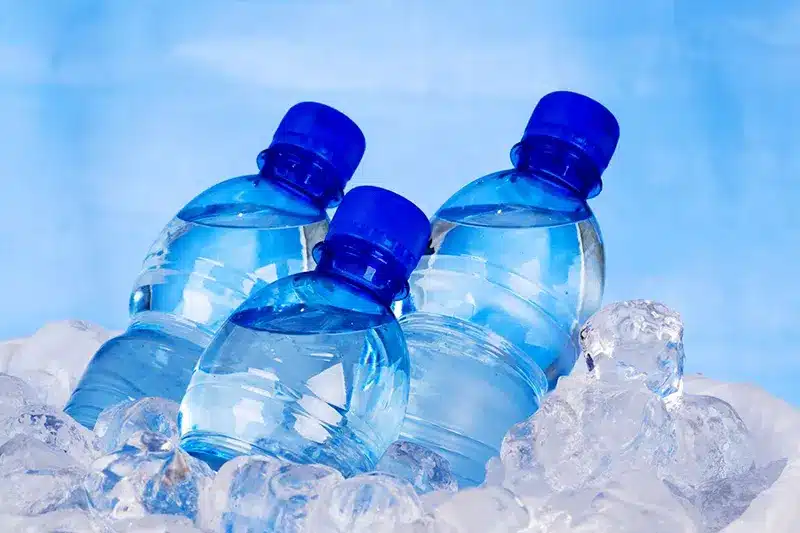
High-Density Polyethylene (HDPE): This type of plastic is commonly used in containers for milk, juice, and other non-carbonated beverages. It is considered safe for food use but not recommended for heating.
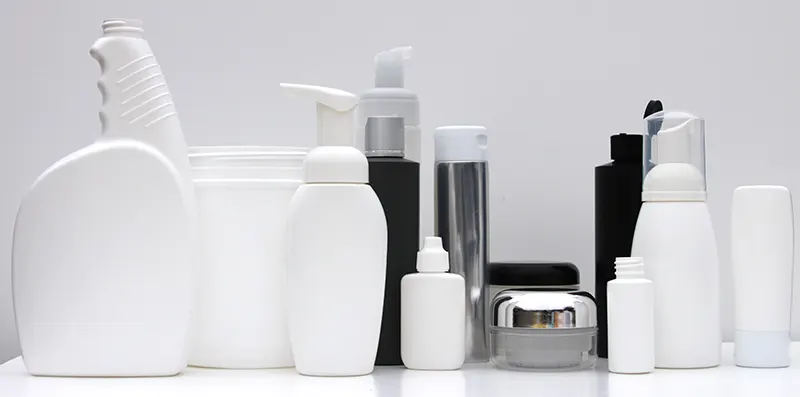
Polyvinyl Chloride (PVC): This type of plastic is used in clear food packaging and cling wraps. It is not considered safe for food and should not be used for heating food.
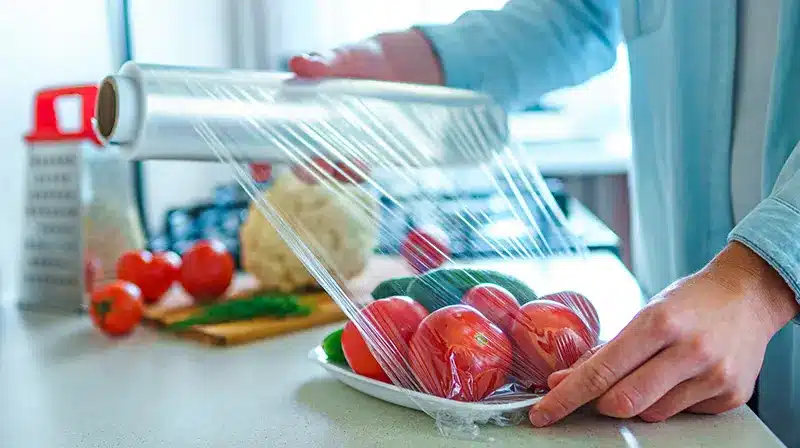
Low-Density Polyethylene (LDPE): This type of plastic is commonly used in squeezable bottles, bread bags, plastic bags, and produce bags. It is considered safe for food use but not recommended for heating.
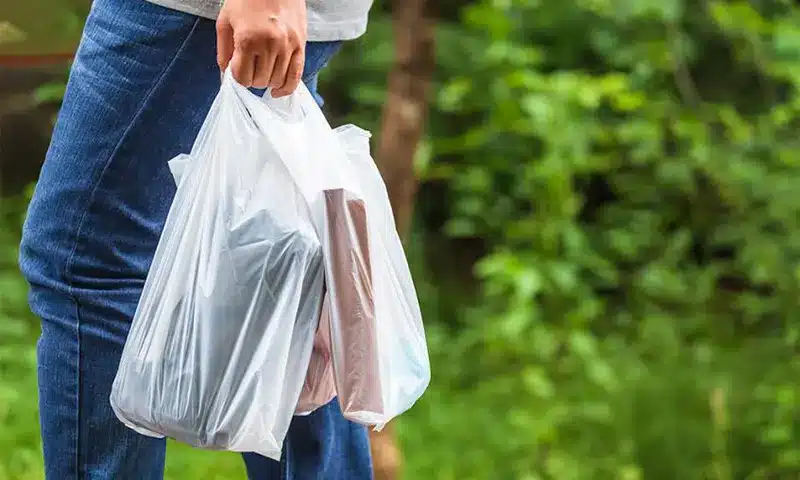
Polypropylene (PP): This type of plastic is used in containers for yogurt, margarine, and other food products. It is considered safe for food use and can be used for reheating food, but it is not recommended for use in the microwave.
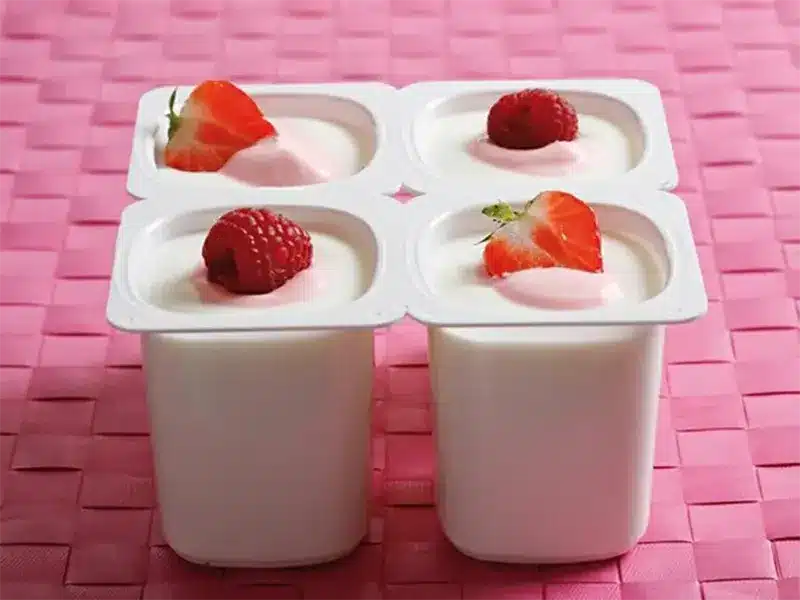
Health Risks Associated with Heating Food in Plastic Containers
Bisphenol-A (BPA) is a chemical commonly used to produce polycarbonate plastics and epoxy resins. It’s a hormone disruptor, meaning it can mimic the effects of estrogen in the body and interfere with the normal functioning of hormones.
The following are some of the potential effects of BPA exposure on human health:
Reproductive issues: Exposure to BPA has been related to hormonal imbalances in men and women, lower fertility, early puberty, and other reproductive issues.
Obesity: Ingestion of BPA is associated with a higher risk of obesity, metabolic diseases, and insulin resistance.
Cancer: Breast and prostate cancer risks have both been found to rise with BPA exposure.
Mental Development: Behavioral issues, altered brain development, and an increased risk of learning and developmental difficulties have all been related to BPA exposure throughout pregnancy and the early years of life.
Heart disease: It has been established that BPA exposure increases the chance of developing heart disease, high blood pressure, and inflammation.
It is essential to minimize exposure to BPA and other harmful chemicals by following recommended food storage and heating guidelines. Avoiding the use of damaged or worn plastic containers, and opting for BPA-free and glass or ceramic options when possible.
Other harmful chemicals found in plastic containers
In addition to Bisphenol-A (BPA), several other dangerous compounds are frequently discovered in plastic packaging:
Phthalates
Phthalates are a class of compounds used to increase the flexibility and durability of plastic products. These substances are hormone disruptors that have been connected to issues with reproduction, developmental issues, and other health issues.
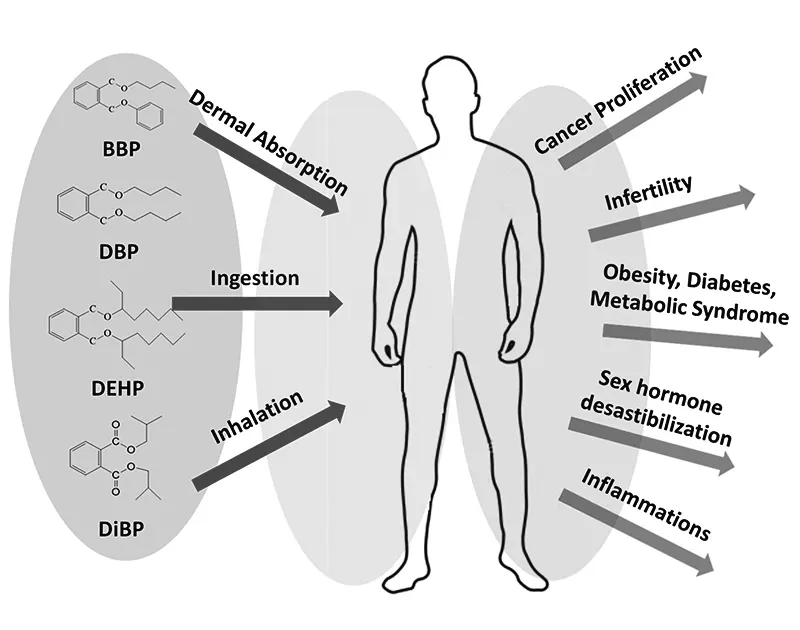
Styrene
Styrene is a substance that can contaminate food and drink and is used to make polystyrene containers like Styrofoam. Styrene has been associated with health issues, including cancer, genetic damage, and neurological impacts. It is a probable carcinogen.
Per- and poly-fluoroalkyl substances (PFASs)
The term “per- and poly-fluoroalkyl substances” (PFAS) refer to a class of chemicals used in manufacturing food packaging and non-stick coatings.
They can build up in a person’s body and are highly persistent in the environment. They have been connected to several health issues, including cancer and developmental and immune system problems.
Dioxins
Dioxins are a class of substances created both during the production of specific plastics and as a byproduct of incineration.
Exposure to even low levels can have serious health effects, including cancer, developmental disorders, and immune system issues because they are highly toxic and persistent in the environment.
Alternatives to Plastic Containers for Heating Food
Several alternatives to plastic containers for heating food are safer and healthier options. As mentioned, plastic food storage can break down over time, especially when exposed to high heat, increasing the risk of chemical release.
Using alternatives to plastic containers is also better for the environment, as they are typically reusable and more environmentally friendly.
Here is the list of possible heating container alternatives aside from the plastic ones:
Glass
Food can be safely heated in glass containers on the stovetop or microwave since they don’t leach dangerous chemicals into the food. Additionally, they are reusable, eco-friendly, and simple to clean.
Ceramic
Food can be safely heated in ceramic containers on the stovetop or microwave since they don’t leach dangerous chemicals into the food. Although they can be reused, they might not be as robust as glass and are more prone to chipping and cracking.
Stainless Steel
Food can be safely heated in stainless steel containers on the stove since they don’t leach toxic chemicals into the food. They may not be suited for use in the microwave, but they are also sturdy and reusable.
Silicone
Flexible, non-stick, and simple to clean, silicone containers are secure for use to microwave food. It is crucial to adhere to the manufacturer’s heating instructions because certain studies have found that silicone may leak toxic compounds into the food when heated to high degrees.
You might also be interested in exploring alternatives to both plastic containers and common cookware like Teflon.
How to Reheat Food Safely in Plastic Food Containers
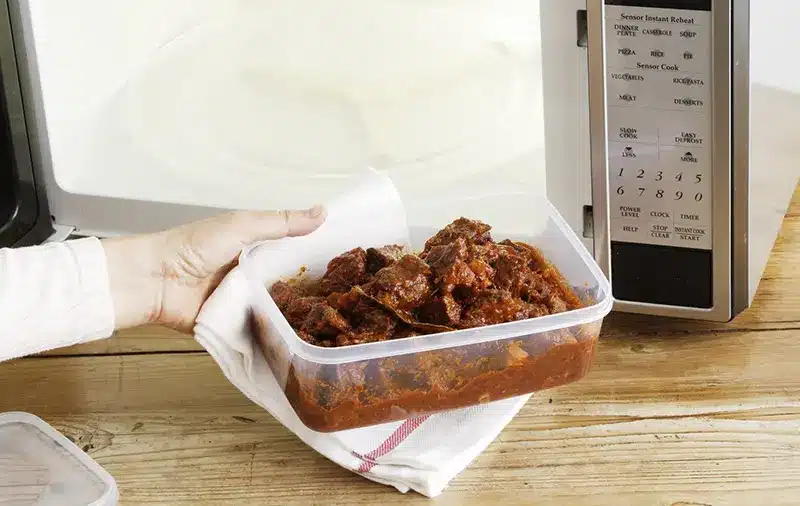
Here are some pointers for microwave-safe food rewarming in plastic containers:
- Look for containers that are marked as BPA-free or microwave-safe on the label. When exposed to intense heat, these containers are less likely to leak dangerous substances into the food.
- Use low heat to lessen the chance of chemical release from the container, and reheat food in the microwave on the lowest power level.
- Avoid overheating. Be sure to adhere to the manufacturer’s heating time and temperature recommendations. Food stored in plastic containers runs the danger of chemical release if the plastic is broken down by excessive heat.
- Food should be transferred to a secure container before being heated in the microwave if the plastic container is not marked as microwave-safe or BPA-free. Reliable alternatives include glass, ceramic, and stainless steel.
- Use plastic containers without sharp edges, fissures, or other flaws, as these can increase the danger of chemical release.
- Keep the lid off. When reheating food in the microwave, avoid covering it with a lid or plastic wrap since this can trap steam and increase the danger of chemical release.
- Throw away old containers. Using a new, safer container would be preferable instead of an old, cracked, or discolored plastic one.
You may lessen your exposure to hazardous chemicals and microwave-safely reheat food in plastic containers by heeding the advice in this article.
Ideas to Remember
In summary, heating food in plastic containers risks human health due to hazardous chemicals, including Bisphenol-A (BPA) and phthalates, that can leak into food.
Alternatives, such as glass or ceramic plates and silicon, are safer for heating food because they don’t contain these dangerous compounds and are typically considered more enduring and environmentally friendly.
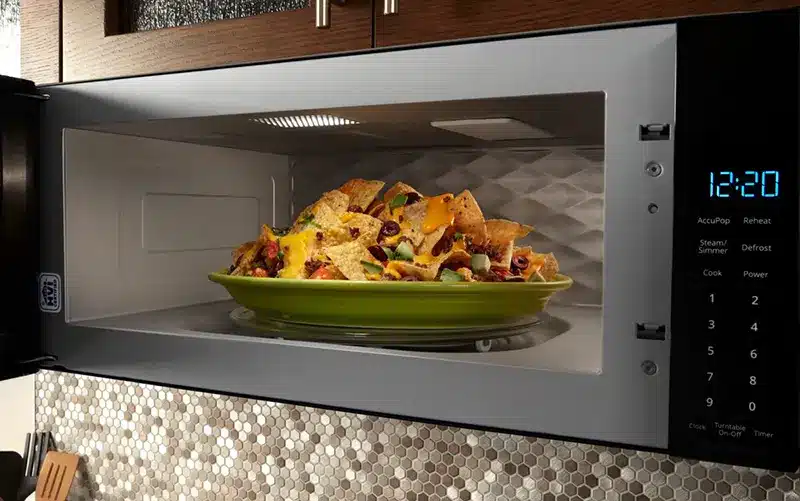
Customers should be informed of the possible dangers of heating food in plastic containers and take precautions to reduce exposure by utilizing substitutes whenever available.
Individuals can safeguard their health and the health of the environment by choosing to heat food in safer containers.

